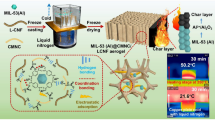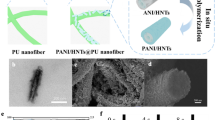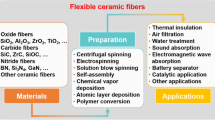Abstract
Polyacrylonitrile (PAN)/cellulose nanofibril (CNF) based carbon nanofiber membranes were produced by electrospinning and carbonization method, in which the CNF amount was 1 wt%. In order to control the spinning process, the rheological properties of the PAN/CNF suspensions were measured before electrospinning. In addition, the effects of CNF particle size on the structure and properties of carbon nanofiber membranes were investigated systematically by SEM, FTIR and mechanical test. Meanwhile, the reaction mechanism of PAN and PAN/CNF nanofiber membranes in the process of stabilization and carbonization was also fully discussed. The results show that the addition of CNFs can improve the breaking strength and conductivity of PAN carbon nanofiber membrane. Moreover, CNFs also can accelerate the carbonization rate and reduce the reaction conditions of PAN nanofiber membranes. Therefore, CNFs are effective enhancers for PAN based carbon nanofiber membranes.

















Similar content being viewed by others
References
Batista MD, Drzal LT (2018) Carbon fiber/epoxy matrix composite interphases modified with cellulose nanocrystals. Compos Sci Technol 164:274–281
Beck S, Roman M, Gray DG (2005) Effect of reaction conditions on the properties and behavior of wood cellulose nanocrystal suspensions. Biomacromol 6(2):1048–1054
Cao Y (2014) Nano-modification for high performance cement composites with cellulose nanocrystals and carbon nanotubes. Diss Theses Gradworks 30:1–24
Grunert M, Winter WT (2002) Nanocomposites of cellulose acetate butyrate reinforced with cellulose nanocrystals. J Polym Environ 10(1–2):27–30
Habibi Y, Lucia LA, Rojas OJ (2010) Cellulose nanocrystals: chemistry, self-assembly, and applications. Chem Rev 110(6):3479–3500
Hu S, Lee CY, Chiu HT (2019) Chemical vapor deposition of carbon nanocoils three-dimensionally in carbon fiber cloth for all-carbon supercapacitors. ACS Omega 4(1):195–202
Jong S, Koo H, Yoo JE (2002) Large scale synthesis of carbon nanotubes by plasma rotating arc discharge technique. Diam Relat Mater 11(3–6):914–917
Jost K, Stenger D, Perez CR (2013) Knitted and screen printed carbon-fiber supercapacitors for applications in wearable electronics. Energy Environ Sci 6:2698–2705
Mao X, Hatton T, Rutledge G (2013) A review of electrospun carbon fibers as electrode materials for energy storage. Curr Org Chem 17(13):1390–1401
Nam SJC (1999) Viscoelastic characterization of phenolic resin-carbon fiber composite degradation process. J Polym Sci Part B Polym Phys 37:907–918
Peresin MS, Habibi Y, Zoppe JO (2010) Nanofiber composites of polyvinyl alcohol and cellulose nanocrystals: manufacture and characterization. Biomacromol 11(3):674–681
Ruiz R, Bedia J, Lallave M (2002) The production of submicron diameter carbon fibers by the electrospinning of lignin. Carbon 48(3):696–705
Suktha P, Sawangphruk M (2017) Electrospinning of carbon-carbon fiber composites for high-performance single coin-cell supercapacitors: effects of carbon additives and electrolytes. Ind Eng Chem Res 7:02797
Szab L, Sari I, Naohiro K (2018) Carbon fibre reinforced cellulose-based polymers: intensifying interfacial adhesion between the fibre and the matrix. RSC Adv 8(40):22729–22736
Wang Z, Dai Q, Porter D (2016) Investigation of microwave healing performance of electrically conductive carbon fiber modified asphalt mixture beams. Constr Build Mater 126:1012–1019
Zou G, Zhang D, Dong C (2006) Carbon nanofibers: synthesis, characterization, and electrochemical properties. Carbon 44(5):828–832
Acknowledgments
Authors are thankful to the granting financial support under Shanghai University of Engineering and Science Talents Zhi Hong Project (No. 2017RC432017), and National Natural Science Foundation of China (No. 51903152), and Shanghai Science and Technology Talent Project (No. 19YF1417900), and the Research Initiation Funds of Shanghai University of Engineering Science (No. E3-0507-19-05164), and Shanghai Local Capacity-Building Project (No. 19030501200).
Author information
Authors and Affiliations
Corresponding authors
Ethics declarations
Conflict of interest
No potential conflict of interest was reported by the authors.
Additional information
Publisher's Note
Springer Nature remains neutral with regard to jurisdictional claims in published maps and institutional affiliations.
Rights and permissions
About this article
Cite this article
Xu, W., Xin, B. & Yang, X. Carbonization of electrospun polyacrylonitrile (PAN)/cellulose nanofibril (CNF) hybrid membranes and its mechanism. Cellulose 27, 3789–3804 (2020). https://doi.org/10.1007/s10570-020-03006-y
Received:
Accepted:
Published:
Issue Date:
DOI: https://doi.org/10.1007/s10570-020-03006-y




